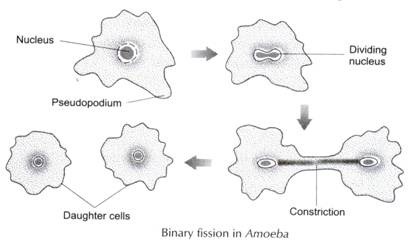ADVERTISEMENTS:
Experiment to Observe Binary Fission in Amoeba and Budding in Yeast !
Experiment:
Objective:
To study (a) binary fission in Amoeba and (b) budding in yeast with the help of prepared permanent slides.
Apparatus and Materials Required:
Permanent slides of Amoeba showing binary fission and yeast in budding, and a compound microscope.
Theory:
ADVERTISEMENTS:
Reproduction is one of the basic characteristics of a living organism. An organism reproduces to produce more of its own kind. Reproduction may be either asexual or sexual.
The type of reproduction that takes place without gametes forming is called asexual reproduction. Sexual reproduction is the type of reproduction in which both the male and female gametes are involved.
Asexual reproduction is common in lower plants and some lower animals. It is a process of rapid multiplication in which the new organisms produced are genetically identical to the parent. Sexual reproduction is common in higher plants and most animals. The organisms produced by this method are not genetically identical to the parents.
Asexual reproduction may be of various types such as binary fission, multiple fission, budding, fragmentation, sporulation and vegetative propagation.
Procedure:
ADVERTISEMENTS:
1. Observe each permanent slide first under the low-power magnification and then under the high-power magnification of a compound microscope.
2. Draw diagrams and compare their features.
Observations:
Binary fission in Amoeba:
1. In this division, two similar individuals are formed from a single parent.
2. A mature Amoeba cell is larger. Its nucleus elongates and gradually divides amitotically into two.
3. The division of the nucleus is followed by the division of the cytoplasm.
4. Thus two new amoebae are formed from a single parent and the parent’s identity is lost.
1. In this type of asexual reproduction, bulblike projections called buds arise from the parent body.
ADVERTISEMENTS:
2. Mature yeast cells are larger, and spherical or oval in shape.
3. One or more bulblike projections (buds) arise from the cell membrane.
4. The nucleus of the parent cell divides and one of the daughter nuclei passes into the bud.
ADVERTISEMENTS:
5. The bud is finally separated from the parent body and grows into a new individual.
6. The parent’s identity is maintained in budding.
Result:
The prepared slides show asexual reproduction in which only one individual is involved in the production of new individuals.
Precautions:
1. Focus the slides properly.
ADVERTISEMENTS:
2. Study the slides first under low-power magnification and then under high-power magnification of the compound microscope.
3. Draw diagrams as seen under the microscope.


